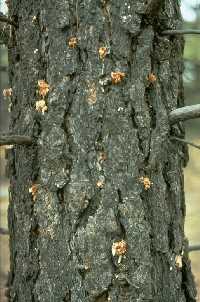Mountain Pine Beetle
by D.A. Leatherman, I. Aguayo, and T.M. Mehall* (9/11)
Quick Facts…
- Mountain pine beetles (MPB) are the most important insect pest of Colorado’s pine forests. MPB often kill large numbers of trees annually during outbreaks.
- Trees that are not growing vigorously due to old age, crowding, poor growing conditions, drought, fire or mechanical damage, root disease and other causes are most likely to be attacked.
- For a long-term remedy, thin susceptible stands. Leave well-spaced, healthy trees.
- For short-term controls, spray, cover, burn or peel attacked trees to kill the beetles. Preventive sprays can protect green, unattacked trees.
 |
 |
Figure 1: Adult Dendroctonus (left) versus Ips (right). Note gradually curved wing of Dendroctonus. Actual size of Dendroctonus from 1/8 to 1/3 inch, Ips 1/3 to 1/4 inch. |
|
Mountain pine beetle (MPB), Dendroctonus ponderosae, is native to the forests of western North America. Periodic outbreaks of the insect, previously called the Black Hills beetle or Rocky Mountain pine beetle, can result in losses of millions of trees. Outbreaks develop irrespective of property lines, being equally evident in wilderness areas, mountain subdivisions and back yards. Even windbreak or landscape pines many miles from the mountains can succumb to beetles imported in infested firewood.
Mountain pine beetles develop in pines, particularly ponderosa, lodgepole, Scotch and limber pine. Bristlecone and pinyon pine are less commonly attacked. During early stages of an outbreak, attacks are limited largely to trees under stress from injury, poor site conditions, fire damage, overcrowding, root disease or old age. However, as beetle populations increase, MPB attacks may involve most large trees in the outbreak area.
A related insect, the Douglas-fir beetle (D. pseudotsugae), occasionally damages Douglas-fir. Most often, outbreaks are associated with previous injury by fire or western spruce budworm. (See fact sheet 5.543, Western Spruce Budworms). Spruce beetle (D. rufipennis) is a pest of Engelmann and Colorado blue spruce in Colorado. Injured pines also can be attacked by the red turpentine beetle (D. valens).
Mountain pine beetles and related bark beetles in the genus Dendroctonus can be distinguished from other large bark beetles in pines by the shape of the hind wing cover (Figure 1, top). In side view, it is gradually curved. The wing cover of Ips or engraver beetles, another common group of bark beetles attacking conifers, is sharply spined (Figure 1, bottom).
Signs and Symptoms of MPB Attack
- Popcorn-shaped masses of resin, called “pitch tubes,” on the trunk where beetle tunneling begins. Pitch tubes may be brown, pink or white (Figures 2 and 6).
- Boring dust in bark crevices and on the ground immediately adjacent to the tree base.
- Evidence of woodpecker feeding on trunk. Patches of bark are removed and bark flakes lie on the ground or snow below tree.
- Foliage turning yellowish to reddish throughout the entire tree crown. This usually occurs eight to 10 months after a successful MPB attack.
- Presence of live MPB (eggs, larvae, pupae and/or adults) as well as galleries under bark. This is the most certain indicator of infestation. A hatchet for removal of bark is needed to check trees correctly (Figures 3, 5 and 8).
- Bluestained sapwood (Figure 9). Check at more than one point around the tree’s circumference.
|
|
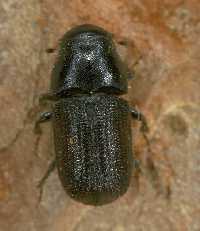 Figure 3: Top view of adult MPB (actual size, 1/8 to 1/3 inch). Figure 3: Top view of adult MPB (actual size, 1/8 to 1/3 inch). |
|
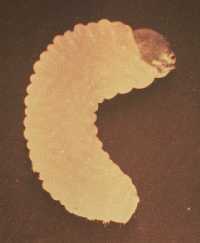
Figure 5: Larva of MPB (actual size, 1/8 to 1/4 inch). These are found under the bark in tunnels. |
||
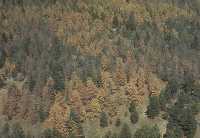 |
||
Figure 4: Mountain area infested by MPB, showing three years of mortality. Old, dead trees are gray; newly killed trees are straw yellow or orange. Some trees may also be infested but do not turn color until nine months or so under attack. |
Life History and Habits
Mountain pine beetle has a one-year life cycle in Colorado. In late summer, adults leave the dead, yellow- to red-needled trees in which they developed. In general, females seek out large diameter, living, green trees that they attack by tunneling under the bark. However, under epidemic or outbreak conditions, small diameter trees may also be infested. Coordinated mass attacks by many beetles are common. If successful, each beetle pair mates, forms a vertical tunnel (egg gallery) under the bark and produces about 75 eggs. Following egg hatch, larvae (grubs) tunnel away from the egg gallery, producing a characteristic feeding pattern.
 |
 |
|
Figure 6: Not all pitch tubes indicate successful attacks. Note the beetle trapped in this large pitch tube. If the majority of tubes look like this, the tree may have survived the current year’s attack. |
Figure 7: Checking beneath the bark for MPB. This attack was successful (note tunnels and stain). |
|
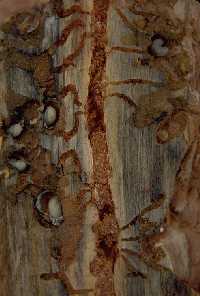 |
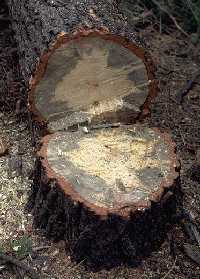 |
|
Figure 8: Characteristic tunnels (galleries) of mountain pine beetle made by the adults and larvae. The underbark area looks like this in late spring. Bluestained wood is caused by fungi the beetles introduce. |
Figure 9: Cut tree killed by MPB, showing the characteristic bluestaining pattern. |
MPB larvae spend the winter under the bark. Larvae are able to survive the winter by metabolizing an alcohol called glycerol that acts as an antifreeze. They continue to feed in the spring and transform into pupae in June and July. Emergence of new adults can begin in mid-June and continue through September. However, the great majority of beetles exit trees during late July (lodgepole pine) and mid-August (ponderosa pine).
A key part of this cycle is the ability of MPB (and other bark beetles) to transmit bluestain fungi. Spores of these fungi contaminate the bodies of adult beetles and are introduced into the tree during attack. Fungi grow within the tree and assist the beetle in killing the tree. The fungi give a blue-gray appearance to the sapwood.
Infested Trees
- Once MPB infests a tree, nothing practical can be done to save that tree.
- Under epidemic or outbreak conditions, enough beetles can emerge from an infested tree to kill at least two, and possibly more, trees the following year.
- Ips and related beetles that emerge early in summer often are mistaken for mountain pine beetle, leading to early reports that “MPB is flying.” Be sure to properly identify the beetles you find associated with your trees.
- Trees from which MPB have already emerged (look for numerous round, pitch-free exit holes in bark) do not need to be treated.
- The direction and spread rate of a beetle infestation is impossible to predict. However, attacked trees usually are adjacent to or near previously killed trees.
Control
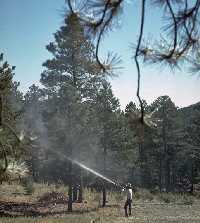 |
Figure 10: Large, uninfested pine being preventively sprayed. This protects high-value trees and should be done annually between April 1 and July 1. |
Natural controls of mountain pine beetle include woodpeckers and insects such as clerid beetles that feed on adults and larvae under the bark. However, during outbreaks these natural controls often fail to prevent additional attacks.
Extreme cold temperatures also can reduce MPB populations. For winter mortality to be a significant factor, a severe freeze is necessary while the insect is in its most vulnerable stage; i.e., in the fall before the larvae have metabolized glycerols, or in late spring when the insect is molting into the pupal stage. For freezing temperatures to affect a large number of larvae during the middle of winter, temperatures of at least 30 degrees below zero (Fahrenheit) must be sustained for at least five days.
Logs infested with MPB can be treated in various ways to kill developing beetles before they emerge as adults in summer.
One very effective way to kill larvae developing under the bark (though very labor intensive) is by peeling away the bark, either by hand or mechanically; this exposes the larvae to unfavorable conditions — the larvae will dehydrate, starve and eventually die. Logs my also be burned or scorched in a pile — preferably when there is snow on the ground (contact your local forester for assistance). They can also be buried under at least eight inches of soil, or chipped. Following beetle emergence, wood can be used without threat to other trees.
Chemical control options for MPB larvae have been greatly limited in recent years. At present, there are no labeled pesticides for use on MPB.
Solar treatments may be appropriate in some areas of Colorado to reduce beetle populations in infested trees. For the treatment to be effective, the temperature under the bark much reach 110 degrees Fahrenheit or more. Such treatments can be performed with or without plastic. This method is also labor intensive; contact your local forester for more details on solar treatments.
Prevention
An important method of prevention involves forest management. In general, MPB prefers forests that are old and dense. Managing the forest by creating diversity in age and structure with result in a healthy forest that will be more resilient and, thus, less vulnerable to MPB. Most mature Colorado forests have about twice as many trees per acre as those forests which are more resistent to MPB. Contact your local forester for more information on forest management practices.
Certain formulations of carbaryl (Sevin and others) permethrin (Astro, Dragnet and others), and bifenthrin (Onyx) are registered for use to prevent attacks on individual trees. These sprays are applied to living green trees in early summer to kill or deter attacking beetles. This preventive spray is generally quite effective through one MPB flight (one year).
 |
Figure 11: The appearance of a forest thinned to help prevent MPB. This can also improve mountain views and reduce fire hazard. |
During epidemic conditions, the pressure from beetle populations may result in less satisfactory results due to several factors:
- Misidentification of healthy trees: Under dry conditions, trees may not produce pitch tubes when infested, therefore healthy trees are not as obvious. Time may need to be spent looking for sawdust around a tree’s circumference and at the base of the tree.
- Timing of application: Trees sprayed after June may already have been attacked.
- Improper coverage: Spray may not have been applied high enough (up to where the trunk tapers to less that six inches), or spray coverage of the tree did not begin at ground level, or was not applied to the entire circumference of the tree (thus creating “windows” for beetle attack).
- Improper dosage/mixing of chemical: Low dosage — effective dosages for bark beetles are higher than the percent used for other insects. Mixture — the carbaryl and water were not fully mixed.
- Environmental conditions: Significant rain or moisture within two hours of application may wash off the insecticide. Very high temperatures may break down the chemical (this can occur when treated trees are near forest fires).
- Chemical shelf life/storage: Manufacturers guarantee stable chemical properties for at least two years after manufacturing date, if stored properly. Chemical properties of carbaryl may be altered if stored at very high or very low temperatures.
- Improper volume/formulation: Not enough spray is used to cover the bark area susceptible to beetle attack; lodgepole pine has “flaky” bark which may require more spray. The label on the chemical does not indicate bark beetle prevention (if using Sevin, SL or XLR is recommended).
Always carefully read and follow all label precautions before applying insecticides for MPB prevention.
For full access to the CSU website as well as this article, please visit this link.
Related Fact Sheets
- 5.543, Western spruce budworms
- 5.558, Ips beetles
